Systematically Creating Coincidental Product Evolution Case Studies of the Application of the Systematic Inventive Thinking® (SIT) Method in the Chemical Industry
Abstract: The article shows the need for an unconventional innovation methodology within the field of new product development (NPD). Systematic Inventive Thinking (SIT) is such a method which has been applied successfully in the chemical industry. An overview of the method, together with case studies from the industry, demonstrates the value of this departure from traditional thinking and other, more widespread, innovation methods.
Introduction
You have, no doubt, heard the following story, or similar versions of it, numerous times. The story begins in 1938 with the inadvertent discovery by Du Pont chemist Dr. Roy J. Plunkett of a highly unusual new substance. According to legend, Dr. Plunkett had set out to invent a nontoxic refrigerant, but when his assistant, Jack Rebok unintentionally cracked the valve on the special bottle of Freon, surprisingly, no gas came out. Sawing open the cylinder, they noted that the frozen, compressed sample of tetrafluoroethylene, had polymerized spontaneously into a white, waxy powder form of polytetrafluoroethylene (PTFE). Trying to identify the properties of the substance, they found that it was absolutely stable: neither heat nor electricity nor acids, nor solvents would react to it. It was the slipperiest substance on earth.[11] The invention of Teflon® was, in essence, a product of accident and coincidence. But is there another moral to this tale? In addition to the understandable drive to find solutions to problems, there may be a benefit in looking at what you have and searching for the problems that it solves.
The present article begins with a theoretical review of the process though which the Systematic Inventive Thinking method is applied, a structured process similar to the accidental one described above. The review will demonstrate why there is a need for the SIT approach to innovation as a supplement to the way that companies typically go about innovating. The subsequent sections of the article show that the thinking tools that form the core of the SIT method are clearly relevant to the chemical industry, first by analyzing one recent innovation in the field. Later, we bring 2 case studies showing how different chemical companies are actively using the SIT method in order to invent new products and technological platforms, as well as a comparison between the two.
How do companies find ideas for new products?
Suppose you want to come up with a new product idea. Where do you begin? The challenge in product innovation is to create products that answer unmet needs, especially where a new product addresses a latent need of which even the market was unaware. Unfortunately, most new products tend to be of the former type, and, to make things worse, prone to competition. Why does this happen so often?
Three Sources
Most companies rely on three sources to develop new product ideas: 1) surveying competitors, 2) market knowledge and research [1, 2, 3], 3) and new technologies. The first one cannot result in a differentiated product. While being an important component in a company’s portfolio, the second source – market research – has, surprisingly, been proven to not be conducive to product offerings that distinguish one company from the competition.[4, 5, 6]
To understand why, let’s look at the following example:
Let’s imagine you came up with a really funny joke and told it to a couple of your friends. Each of them would probably tell it to a couple of his or her friends and so on. However, it would take some time before a significant portion of your city’s population would hear it, not to mention your country or state. If we tried to describe the connection between the portion of the population that has heard your joke and the time that has passed since you first told it, it would look something like Figure 1.
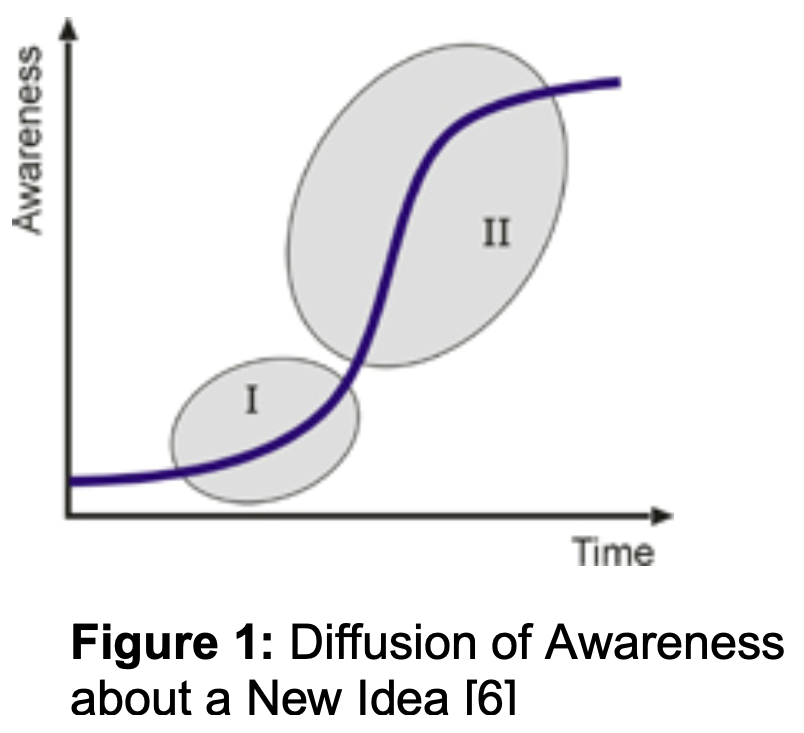
A very similar graph would describe the connection between the awareness to a new need in the market and the portion of the population aware of that need.[10] Observing this graph it is quite clear that any market research, conducted at the section marked I, would have virtually no chance of discovering the new need. It is only in the section marked II that market researches would have a good chance of stumbling upon the new need. Unfortunately, at that point in time it is pretty safe to assume that your competitors’ market research would yield very similar results.[3]
Technology can be a source of differentiation, but only provided that your company has access to technologies that are not available to others.
Systematic Inventive Thinking – a fourth source – an alternative approach to innovation
There is, however, a fourth source for developing new ideas – using existing products as a basis for ideas. Based on internal company resources and expertise, it can serve as a strong differentiating factor between companies that know how to utilize it and those who do not.
Systematic Inventive Thinking (SIT), a novel approach to idea creation and innovation, is based on this source. The method has been used by hundreds of companies in more than forty countries, including several in the chemical industry – Univation Technologies and Bayer Environmental Science, for example – to help them “listen to the voice of their products.” SIT provides a structured process to arrive at innovative ideas for new products and technologies.
At the heart of SIT is a crucial idea: inventive solutions share common patterns. It is evident that inventors unknowingly follow patterns when coming up with new product ideas – patterns that can be identified by observing thousands of products and their evolution. Surprisingly, a majority of new and inventive products can be categorized according to only five patterns.
One of these patterns is called, in SIT parlance, Subtraction. In opposition to the conventional approach to new product development whereby components, attributes or features are added in line with the perceived wants of consumers, with Subtraction, instead of adding components, you remove them – particularly those that seem most essential and indispensable. An example of the Subtraction pattern can be seen in the Pressure Sensitive Adhesives (PSA) industry with the introduction by Dow Corning of solvent-less silicone PSAs.[12] Solvent had been considered an essential component in delivering silicone pressure sensitive adhesives. Nevertheless, by removing it, a new form was conceived which had the performance benefits of typical silicone PSAs such as the ability to maintain adhesion at extremes of temperature and adhesion to low energy surfaces with the added advantage of being non-toxic and non-allergenic.
From Patterns to Tools
Subtraction is only one of the five patterns that form the core of the SIT method for product innovation. But in order to be able to proactively use the patterns to create future innovations rather than to simply categorize historical ones, a systematic process has been developed to apply them. Thus, the patterns become “thinking tools” which can be used to come up with new ideas; in a sense, they systematically create accidents.
This process is called Function Follows Form (FFF), a term coined by cognitive psychologist Ronald Finke.[13] Instead of innovating by identifying a “function” or need and then creating a product accordingly, one first manipulates the existing product and then considers how the new form could of benefit.
Using Function Follows Form, then, one develops products in the reverse order to the market research process. Applying FFF, one begins with an existing concept or product. A list of the product’s physical components and its environment is constructed. Then one of the five thinking tools is used to mentally manipulate the product. These new forms, or “virtual products” in SIT-speak, are immediately assessed as to their business value and feasibility. If the virtual product has both market potential and falls within existing company and technological constraints, it undergoes whatever minor adaptations are needed and is considered worthy of following up. As market knowledge is used here as a filter rather than as the starting point, the ideas generated are likely to be different from those that competitors arrive at by searching the market for ideas.

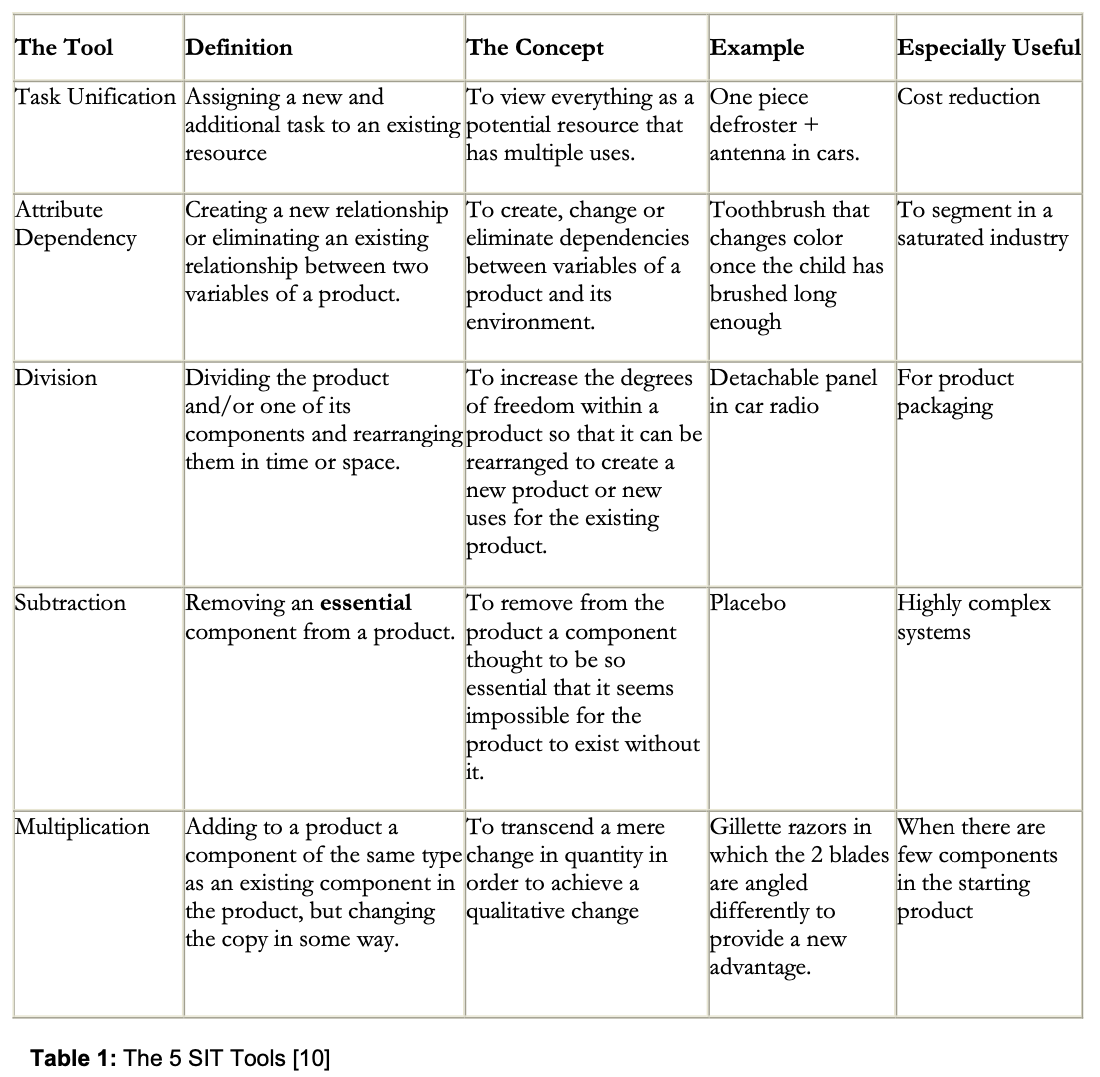
The following sections describe case studies of the application of the SIT method, through the Function Follows Form work process, for the purpose of arriving at innovative product and technological solutions in the chemical industry. In each case, the benefit for the innovation was identified as a secondary step rather than as the starting point of the process, contrary to the conventional approach of first identifying a need and subsequently searching for solutions.
Case Study: Ahava Dead Sea Laboratories
Ahava Dead Sea Laboratories is a world leader in the mineral based cosmetics industry, functionalizing the effects of the unique natural elements found in the Dead Sea. Ahava has been working with the SIT method for two years and the tools can be identified in many of the company’s recent patent registrations.
The Multiplication tool presents a very different, even opposite, approach to the Subtraction tool discussed above. Instead of removing components, as in Subtraction, you replicate or multiply existing components, but alter the copies according to some parameter. It is critical to not simply add more copies, but to change the copies in some way. For example, there are several magnetic minerals in Dead Sea salts and they have been utilized previously in many Dead Sea cosmetic products. In order to launch a new line of cosmetics, Ahava did not simply increase the amount of the existing metallic minerals in its products. Rather, they added other types of metals, to increase the total percentage [US patent application No. 10/519, 38]. This, they realized, would amplify the positive effects of increased blood flow to the areas to which the cosmetic is applied, and thereby give the user an added benefit.
Task Unification, a third SIT tool, is defined as “assigning a new and additional task to an existing resource”. It manifests itself when one of a product’s components – or some other object in the product’s immediate vicinity – is given an additional task without losing its original one. Ahava’s innovative new Gentle Body Exfoliator uses the body’s own moisture to melt the active ingredients through a process of emulsification.
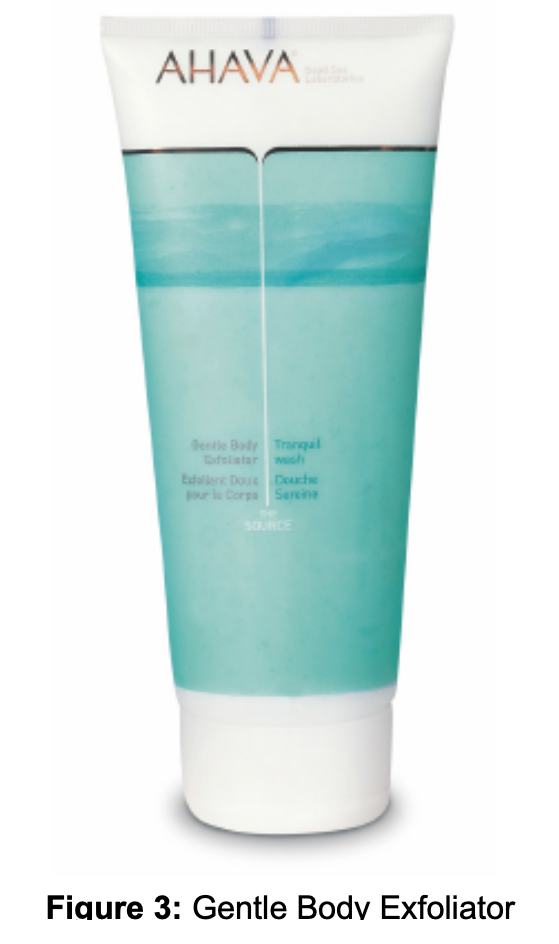
Since the body’s moisture is utilized for the task of activating the cosmetic’s ingredients, Ahava was able to produce the product without adding water. Therefore, when applied, the product is of a rough texture, removing dead skin cells from the surface. However, the cosmetic, with the help of the body’s moisture, shortly dissolves into the skin, to nourish it with the Dead Sea minerals [while not patent pending, this product is based on unique know- how of the company].
A second Ahava patent, a Purifying Mud Mask, demonstrates SIT’s Attribute Dependency tool. Attribute Dependency involves the creation of new relationships between the different variables of a product or its immediate environment. Innovative ideas are often generated by creating new dependencies where they may not currently exist or by modifying or dissolving dependencies where they do. The Attribute Dependency pattern helps accelerate the discovery of products that seem in hindsight to be inevitable. The Purifying Mud Mask product is applied as a typical mud mask, but does not retain that function over time. In fact, the mask undergoes a chemical process that changes it into a “peeling” to remove dead skin. Unlike most 2-in-1 products that have multiple functions at the same time, this product provides both functions but at different times. The ability to imagine the same product changing its properties over time allowed for this breakthrough, as the functions of a Mud Mask and a Peeling would be physically impossible to occur simultaneously.
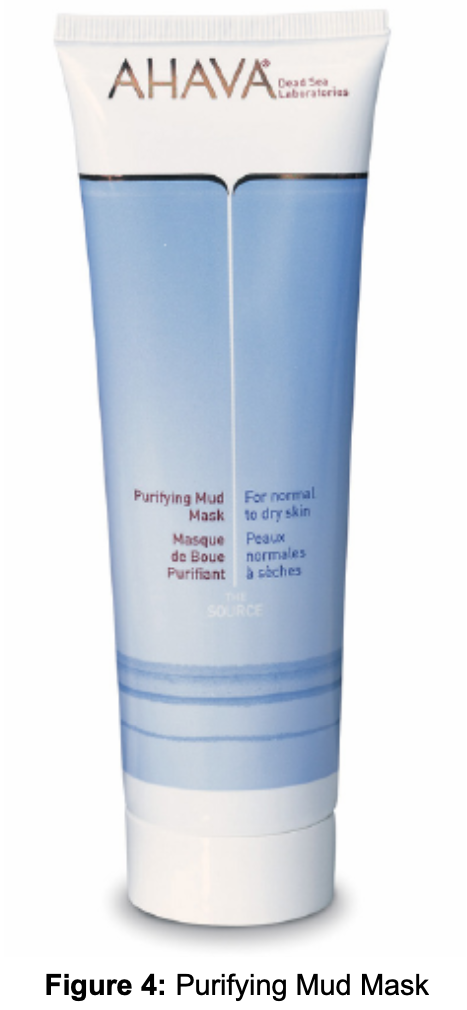
Case Study: Vitco / Unileve
Now that we are familiar with some of the SIT thinking tools and the theory of the process used to apply them, we can review a step-by-step case study of such a process conducted with Vitco Detergents in 1996. That same year, Unilever acquired 60% of the shares of Vitco Israel at a consideration of $13 million, and changed the name to Lever. However, at the time, Vitco sold various products, among them a laundry detergent, and was looking to expand their offering.
Step 1: Define the existing situation by listing the product’s physical components and its immediate environment
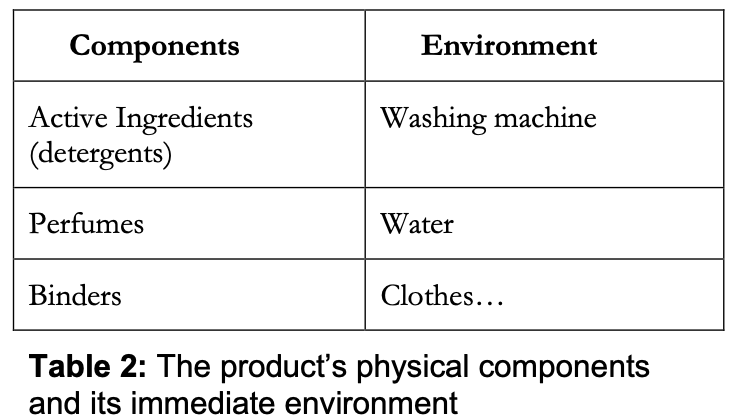
Step 2: Apply one of the five SIT thinking tools
In this case, we applied the Subtraction tool. Identifying the most essential component, we subtracted the Active Ingredients.
Step 3: Define and visualize the virtual product
What we had now was a “detergent” that contained perfumes and binders, but could not clean clothing, as this function was removed along with component that performed it (the Active Ingredients).
Step 4: Identify needs, benefits, and markets
The Virtual Product obviously sounds ridiculous – what is the use of a detergent that doesn’t have an active ingredient? But, as one of the workshop participants noted, the Active Ingredients are very hard on the material of the clothes and actually wear them down. Removing them, would allow the clothes to wear less and last longer. Therefore, a potential market could be those individuals who launder their clothes frequently, not because the clothes are soiled, but because they were worn since their previous laundry cycle and are no longer “fresh”.
Step 5: Identify feasibility
The technical experts believed that they could create a stable product that would contain very little Active Ingredient. It would also need to contain less of the binders that had been used to bind the Active Ingredients to the perfumes.
Step 6: Identify challenges and make adaptations
The main challenge that was raised was that legally, due to industry regulations, this product would not be allowed to be marketed as a “detergent” since it had no cleansing properties. The CEO, who was in the room, immediately gave an answer to the challenge – why not launch a new product that will define a new category- “Clothes Fresheners”.
Vitco never introduced the product described above. Nevertheless, 4 years later (in 2000) Procter & Gamble launched a new category under their Febreze® brand, which they termed “Clothing Refreshers”.[15] Several other companies sell similar products which they call “Laundry Fresheners” or “Laundry Refreshers”. The concept is the same – detergents with substantially less cleaning elements. It is interesting to note that P&G market the category citing an additional benefit not raised in the Vitco process. Namely, clothing refreshers can be utilized in combination with detergents in a wash cycle to add a fresh scent to the clothing.
A Comparison of the Two Case Studies
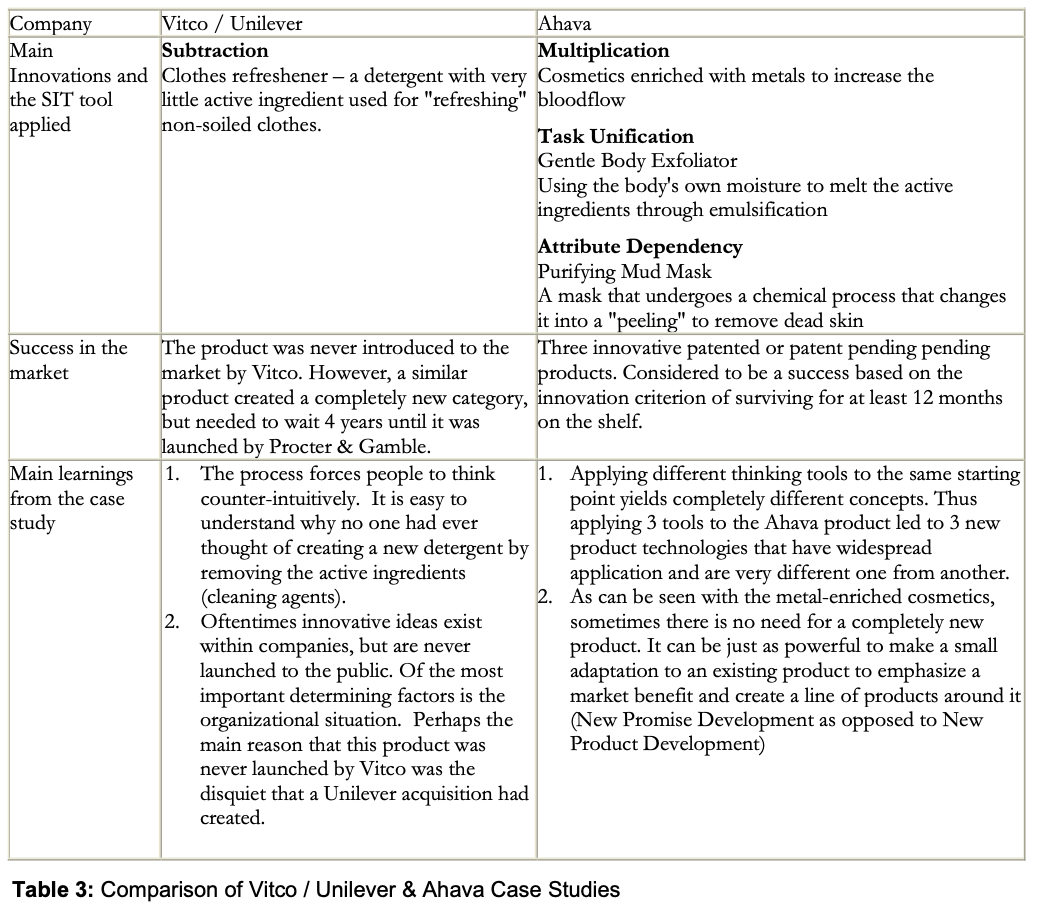
Conclusions
The history of innovations includes many cases of simultaneous innovations, For instance, Edison was not the only light bulb inventor [7], and Bell was not the first to invent the telephone.[8] Even in science, theories and papers are concurrently published on common discoveries, despite the absence of communication between the researchers.
Market research, when applied as the single or preferred method for generating new product ideas, may lead firms to discover emerging needs when it is more than probable that other competitors also discover the same need.[4, 5, 6]
Thus, there is a clear need for an approach that can lead to exclusive discoveries that can take the marketplace by surprise. Such innovative ideas must be captured before the market submits strong signals to its needs, rendering market research methods (for eliciting ideas) less effective.[9]
Let us return now to the Teflon® example, which can now be clearly identified as a case of function following form. Dr. Plunkett and his staff were able to take an inadvertent creation and identify its potential benefits — understanding the value inherent in an accidental discovery. By systematically creating “accidents” through controlled manipulation of the product’s components and its environment, the SIT method, too, does not look to solve known problems in the market, but rather concentrates on what could be done to the present form, with the company’s present resources, in order to create a new one that makes business sense. Accidents do happen, but rather than wait for the unexpected, it makes sense to exploit a systematic method to create these “accidents” in a structured way.
References
[1] Srinivasan, V.; Loveejoy, W. S.; Beach, D., Integrated Product Design for Marketability and Manufacturing. Journal of Marketing Research, 1997.
[2] Kotler, P ., Marketing Management: Analysis, Planning, Implementation and Control. Prenice Hall, New Jersey, 1994.
[3] Crawford, C. M., New Product Management. Irwin, Boston, MA, 1991.
[4] Goldenberg, J.; Efroni, S., Using Cellular Automata Modelling of Emergence of Innovations. Technological Forecasting and Social Change, Vol. 68, Iss. 3, 2001, p. 293-308.
[5] Goldenberg, J.; Mazursky, D., Creativity in Product Innovation. Cambridge, 2001.
[6] Goldenberg, J.; Mazursky, D.; Solomon, S., Templates of original innovation: Projecting original incremental innovations from intrinsic information. Technological Forecasting and Social Change, Vol. 61, Iss.1, 1999, p. 1-12.
[7] Israel, P., Edison: A Life of Invention. New York, 1998.
[8] Adler, B.; Houghton, J., America’s Stupidest Business Directions. New York, 1997.
[9] Goldenberg, J.; Mazursky, D., The Voice of the Product: Templates of New Product Emergence. Innovation and Creativity Management, Vol. 8, Iss. 3, 1999, p. 157-164.
[10] SIT Ltd., SIT Method, Systematic Inventive Thinking, 1998. http://www.sitsite.com.
[11] DuPont, DuPont Fluoropolymers, 2003. http://www.dupont.com/teflon/bakeware/ power.html.
[12] Dow Corning, Adhesives and Specialties, 2000. http://www.dowcorning.com/content/new s/paper_pstc.asp?DCWS.
[13] Fink, R. A.; Ward, T. B.; Smith, S. M., Creative Cognition. Cambridge, MA, 1992.
[14] Goldenberg, J.; Horowitz, R.; Levav, A.; Mazursky, D., Finding your Innovation Sweet Spot. Harvard Business Review, March 2003, p. 120-129.
[15] P&G adds 7 versions of existing brands. Enquirer Business Coverage, 2000. http://www.enquirer.com/editions/2000/0 4/06/fin_p_g_adds_7_versions.html.